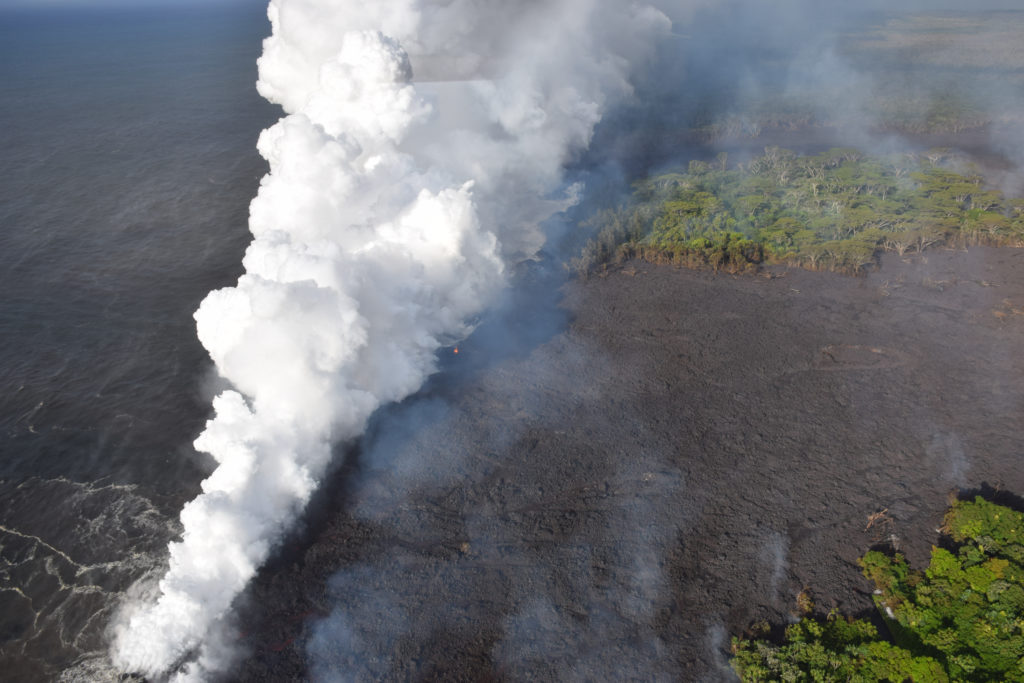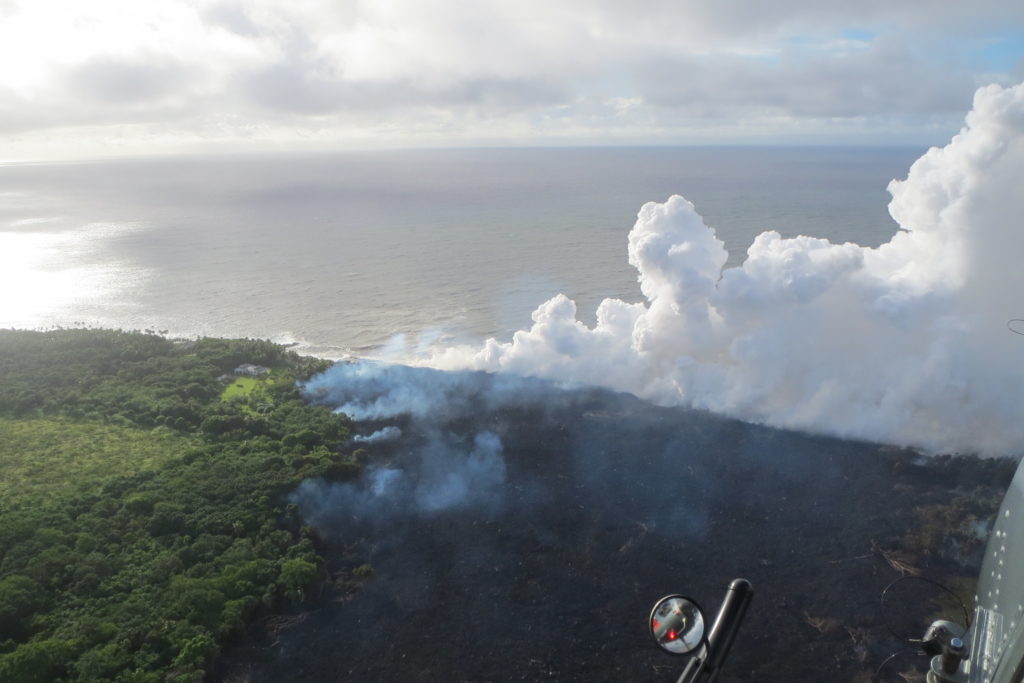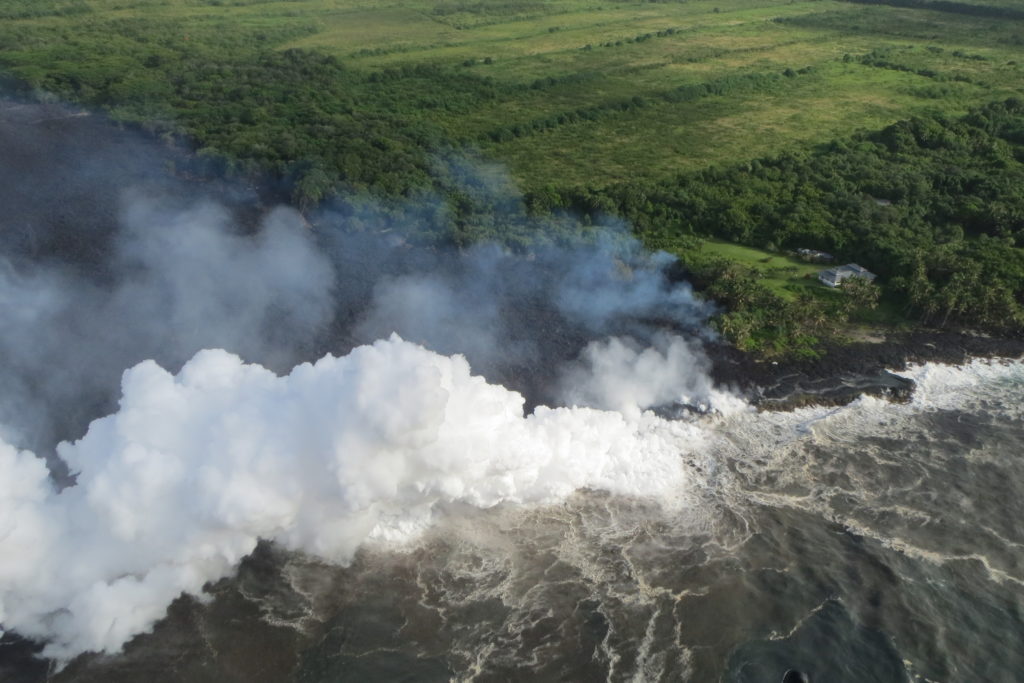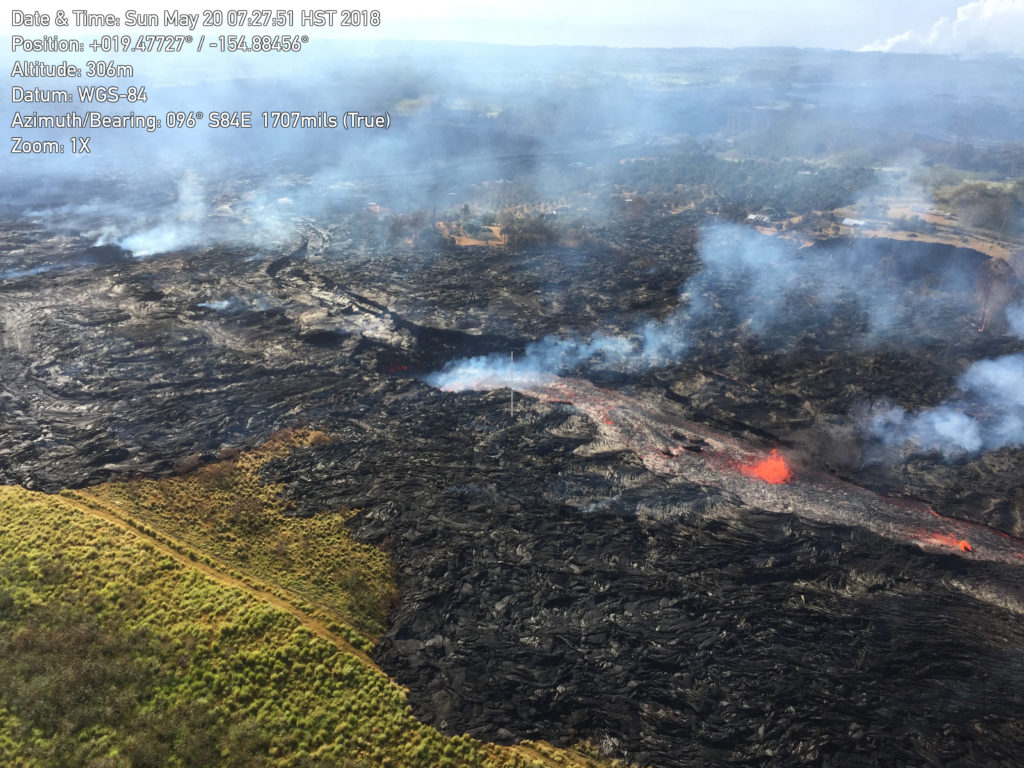Photos: Fissure 20 Lava Flow Reaches the Ocean
The U.S. Geological Survey reports that late last night, the fissure 20 lava flow reached the ocean. Hot lava entering the ocean creates a dense white plume called “laze” (short for “lava haze”).
Laze is formed as hot lava boils seawater to dryness. The process leads to a series of chemical reactions that result in the formation of a billowing white cloud composed of a mixture of condensed seawater steam, hydrochloric acid gas, and tiny shards of volcanic glass. This mixture has the stinging and corrosive properties of dilute battery acid, and should be avoided. Because laze can be blown downwind, its corrosive effects can extend far beyond the actual ocean entry area.
Lava flows from the Fissure 20 complex move downslope and enter the ocean. Lava can be seen in the middle of the channel. A laze plume hides the point of ocean entry.
Lava from the fissure complex erupting in Kīlauea’s lower East Rift Zone entered the ocean in late evening on May 19, 2018.
The active ocean entry is producing a white “laze” plume. Laze is formed when hot lava hits the ocean, forming a plume of hydrochloric acid and steam with fine glass particles. The laze plume travels with the wind and can be a hazard for people downwind, but is most severe in the immediate vicinity of the ocean entry.
A plume rises from the site of the lava ocean entry, viewed on approach by HVO scientists during an overflight of Kīlauea Volcano’s lower East Rift Zone on May 20, 2018, around 6:45 a.m.
Lava from the Fissure 20 complex enters the ocean generating a white laze plume. Helicopter overflight on May 20, 2018, at 6:45 a.m.
View of ocean entry point from helicopter overflight on May 20, 2018, at 6:45 a.m.
The helicopter hovers above the ocean entry on May 20, 2018, around 6:45 a.m. Several braided lava channels (red) are visible on the right.
The white plume is “laze,” which forms when hot lava hits the ocean sending hydrochloric acid and steam with fine glass particles into the air. Laze is a health hazard for people downwind and especially in the immediate vicinity of the plume.
Lava from the eastern channel of the Fissure 20 complex flows into a crack in the ground. The crack opened in the early morning hours of May 20, 2018.
Prior to opening, lava was flowing vigorously down a channel. After the crack formed, the lava began pouring into the ground.
Lava from the eastern channel of the Fissure 20 complex is flowing into a crack in the ground that opened on the morning of May 20, 2018.
The crack is “robbing” the easternmost channel of lava and the eastern ocean entry is therefore less vigorous than the western entry point (see photos above).
Video of a slow moving lava flow in Kīlauea Volcano’s lower East Rift Zone, taken May 20, 2018, at around 2:31 AM HST. The flow is ~3 m (9 ft) high.
The HVO scientist mapping the flow is about ~15 m (50 ft) away from the flow front. The audio is the sound of burning vegetation and the call of coqui frogs.
Spattering continues from Fissures 6 and 17 with significant lava flows being erupted from Fissures 20. Two of these lava flows from Fissure 20 reached the ocean along the southeast Puna coast overnight; however, a crack opened under the east lava channel early this morning diverting the lava from the channel into underground voids. This may cause changes downslope in the channel system and the ocean entry.
HVO field crews are on site tracking the lava flow and spattering from multiple fissures as conditions allow and reporting information to Hawai‘i County Civil Defense.
Volcanic gas emissions have tripled as a result of the voluminous eruptions from Fissure 20 so SO2 concentrations are likely elevated to higher levels throughout the area downwind of the vents. Moderate trade winds today means that areas downwind of Kilauea gas emission sources may experience varying levels of vog. For forecast information, see: http://mkwc.ifa.hawaii.edu/vmap/hysplit/
For other information about vog, see: https://vog.ivhhn.org/
This eruption is still evolving and additional outbreaks of lava are possible. Ground deformation continues and seismicity remains elevated in the area.
Future outbreaks could occur both uprift (southwest) and downrift (northeast) of the existing fissures, or, existing fissures can be reactivated. Communities downslope of these fissures could be at risk from lava inundation. Activity can change rapidly.























